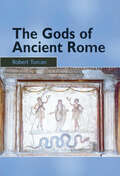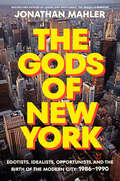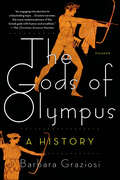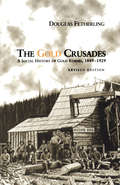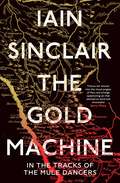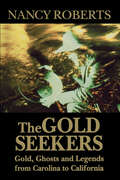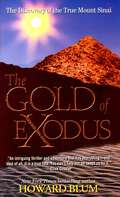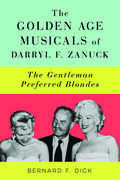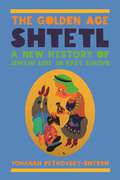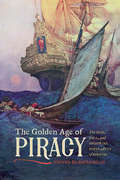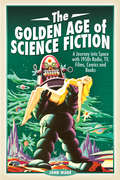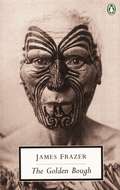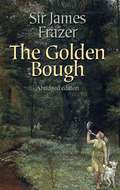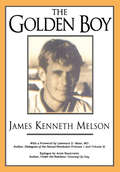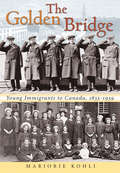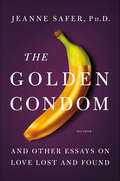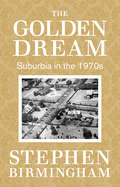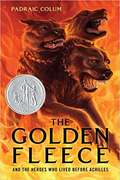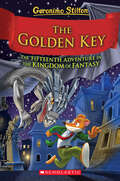- Table View
- List View
The Gods of Ancient Rome: Religion in Everyday Life from Archaic to Imperial Times
by Robert TurcanFirst published in 2001. This is a vivid account of what their gods meant to the Romans from archaic times to late antiquity, and an exploration of the rites and rituals connected to them. After an extensive introduction into the nature of classical religion, the book is divided into three pain main parts: religions of the family and land; religions of the city; and religions of the empire. The book ends with the rise and impact Christianity. Using archaeological and epigraphic evidence, and drawling extensively on a wide range of relevant literary material, this book is ideally suited for undergraduate courses in the history of Rome and its religions. Its urbane style and lightly worn scholarship will broaden its appeal to the large number of non-academic readers with a serious interest in the classical world.
The Gods of New York: Egotists, Idealists, Opportunists, and the Birth of the Modern City: 1986-1990
by Jonathan MahlerA sweeping chronicle of four tumultuous years in 1980s New York that changed the city forever—and anticipated the forces that would soon divide the nation—from the bestselling author of Ladies and Gentlemen, the Bronx Is Burning&“A rip-roaring, sweeping, essential work of history . . . a deeply reported and brilliantly observed account of how the modern city was born and why all of us continue to live with the results.&”—Jonathan Eig, Pulitzer Prize–winning author of King: A LifeNew York entered 1986 as a city reborn. Record profits on Wall Street sent waves of money splashing across Manhattan, bringing a battered city roaring back to life.But it also entered 1986 as a city whose foundation was beginning to crack. Thousands of New Yorkers were sleeping in the streets, addicted to drugs, dying of AIDS, or suffering from mental illnesses. Nearly one-third of the city&’s Black and Hispanic residents were living below the federal poverty line. Long-simmering racial tensions threatened to boil over.The events of the next four years would split the city open. Howard Beach. Black Monday. Tawana Brawley. The crack epidemic. The birth of ACT UP. The Central Park jogger. The release of Do the Right Thing. And a cast of outsized characters—Ed Koch, Donald Trump, Al Sharpton, Spike Lee, Rudy Giuliani, Larry Kramer—would compete to shape the city&’s future while building their own mythologies.The Gods of New York is a kaleidoscopic and deeply immersive portrait of a city whose identity was suddenly up for grabs: Could it be both the great working-class city that lifted up immigrants from around the world and the money-soaked capital of global finance? Could it retain a civic culture—a common idea of what it meant to be a New Yorker—when the rich were building a city of their own and vast swaths of its citizens were losing faith in the systems meant to protect them? New York City was one thing at the dawn of 1986; it would be something very different as 1989 came to a close. This is the story of how that happened.
The Gods of Olympus: A History
by Barbara GraziosiAn elegant and entertaining account of the transformations of the Greek gods across the ages, from antiquity to the Renaissance and the present dayThe gods of Olympus are the most colorful characters of Greek civilization: even in antiquity, they were said to be cruel, oversexed, mad, or just plain silly. Yet for all their foibles and flaws, they proved to be tough survivors, far outlasting classical Greece itself. In Egypt, the Olympian gods claimed to have given birth to pharaohs; in Rome, they led respectable citizens into orgiastic rituals of drink and sex. Under Christianity and Islam they survived as demons, allegories, and planets; and in the Renaissance, they triumphantly emerged as ambassadors of a new, secular belief in humanity. Their geographic range, too, has been little short of astounding: in their exile, the gods and goddesses of Olympus have traveled east to the walls of cave temples in China and west to colonize the Americas. They snuck into Italian cathedrals, haunted Nietzsche, and visited Borges in his restless dreams.In a lively, original history, Barbara Graziosi offers the first account to trace the wanderings of these protean deities through the millennia. Drawing on a wide range of literary and archaeological sources, The Gods of Olympus opens a new window on the ancient world, religion, mythology, and its lasting influence.
The Golan Heights: Political History, Settlement and Geography since 1949 (Routledge Studies in Middle Eastern Politics)
by Yigal KipnisPresenting the settlement landscape of the Golan before and after June 1967, The Golan Heights deals with the issue of the border between Israel and Syria, and with the Israeli settlement process in the area following the Six Day War. The story of the Golan Heights and its position between Syria and Israel does not belong only to the past; it is still interwoven in the political present of the two countries. Public discourse in Israel on the political future of the Golan, and the direct and indirect political discussions between Israel and Syria, rest to a great extent on personal and collective memories, and these, by nature, are based on the past. The perceptions of the Israeli public were constructed upon the image of a mountain that became a monster. This image reached its peak on the eve of the Six Day War in June 1967, but continued to be consolidated and preserved in the Israeli collective memory, and so it has remained until the present. Addressing the question of the political future of the Golan, a central issue for both Israel and the wider Middle East, this book will be an invaluable resource for students and scholars of Political History, Settlement Geography and Geopolitics. Dr. Yigal Kipnis teaches International Relations at Haifa University. He received a BS in Civil Engineering from the Technion in Haifa and an MA and PhD in Land of Israel Studies from Haifa University. His first book, The Mountain That Was as a Monster: The Golan Between Syria and Israel, was published in 2009. His second book, 1973: The Way to War, published in 2012, immediately became a bestseller. It reveals the continuing political process which led to the Middle East war of October 1973.
The Gold Crusades: A Social History of Gold Rushes, 1849-1929
by Douglas FetherlingAmong the hordes of starry-eyed 'argonauts' who flocked to the California gold rush of 1849 was an Australian named Edward Hargraves. He left America empty-handed, only to find gold in his own backyard. The result was the great Australian rush of the 1850s, which also attracted participants from around the world. A South African named P. J. Marais was one of them. Marais too returned home in defeat - only to set in motion the diamond and gold rushes that transformed southern Africa. And so it went. Most previous historians of the gold rushes have tended to view them as acts of spontaneous nationalism. Each country likes to see its own gold rush as the one that either shaped those that followed or epitomized all the rest. InThe Gold Crusades: A Social History of Gold Rushes, 1849-1929, Douglas Fetherling takes a different approach. Fetherling argues that the gold rushes in the United States, Canada, Australia, New Zealand, and South Africa shared the same causes and results, the same characters and characteristics. He posits that they were in fact a single discontinuous event, an expression of the British imperial experience and nineteenth-century liberalism. He does so with dash and style and with a sharp eye for the telling anecdote, the out-of-the-way document, and the bold connection between seemingly unrelated disciplines. Originally published by Macmillan of Canada, 1988.
The Gold Machine: In the Tracks of the Mule Dancers
by Iain SinclairFrom the award-winning author of The Last London and Lights Out for the Territory, a journey in the footsteps of our ancestors. In The Gold Machine, Iain Sinclair and his daughter travel through Peru, guided by – and in reaction to – an ill-fated colonial expedition led by his great-grandfather, Arthur Sinclair. The incursions of Catholic bounty hunters and Adventist missionaries are contrasted with today&’s ecotourists and short-cut vision seekers. The family history of a displaced Scottish highlander fades into the brutal reality of a major land grab. The historic thirst for gold and the establishment of sprawling coffee plantations leave terrible wounds on virgin territory. What might once have been portrayed as an intrepid adventure is transformed into a shocking tale of the violated rights of indigenous people, secret dealings between London finance and Peruvian government, and the collusion of the church in colonial expansion. In Sinclair&’s haunting prose, no place escapes its past, and nor can we.
The Gold Seekers: Gold, Ghosts and Legends from Carolina to California
by Nancy RobertsA history of the earlier Southern gold rush and its legends that—for the first time—ties it to the well-known California gold rush of 1849.Nancy Roberts tells how it all began in North Carolina, which supplied all the domestic gold coined at the US Mint between 1804 and 1828. She tells the story of the discovery of the gold in Virginia, the Carolinas, Georgia, and Alabama and later in California and Colorado, including how the Virginia, Carolina and Georgia gold miners abandoned their mines within weeks after news arrived of the discovery of gold at Sutter’s Creek. And, for a while, they were said to be the only experienced miners in the Western gold fields.Ms. Roberts recreates with gusto and suspense the experiences of real people—the adventurers and entrepreneurs, family men and rascals, immigrants and bandits, entertainers and miners—and also includes several tales of the supernatural from the period.There was North Carolina’s flamboyant Walter George Newman, who fleeced the wolves of Wall Street; “Fool Billy,” who South Carolinians discovered was not a fool at all; a romantic specter called Scarlett O’Hara of the Dorn Mine; Georgian Green Russell, with his beard braided like a pirate, who founded Denver; “Free Jim,” the only black man in Dahlonega to own his own gold mine only to leave it for San Francisco; the Grisly Ghost of Gold Hill; a general from North Carolina who became an influential Californian; the ghost bride of Vallecito; and California’s bandit, the enigmatic Black Bart.
The Gold of Exodus: The Discovery of the True Mount Sinai
by Howard BlumMount Sinai. For many, it is the most sacred place on Earth-the site where God descended to give Moses the Ten Commandments. Yet for centuries, mankind has not known its exact location. In this heart-pounding true story, award-winning journalist and bestselling author Howard Blum tells the enthralling account of two modern-day adventurers-Larry Williams, a two-time Republican candidate for the U.S. Senate from Montana and a self-made millionaire, and his friend Bob Cornuke, a retired policemen and former SWAT team member. Lured by the prospect of finding the fabled fortune in gold that the ancient Hebrews took with them when they fled from Egypt, the two men set out to find the true site of Mount Sinai-with only the Old Testament as a guide. Eminent biblical scholars at Harvard and the University of Pennsylvania have argued that Mount Sinai is not in the Sinai Peninsula at all, but rather in northwestern Saudi Arabia. However, they were never allowed into the kingdom to prove their argument. When Cornuke and Williams are also denied entry, they daringly sneak into Saudi Arabia. And what they discover at the mountain known as Jabal al Lawz will astonish the world-and inspire readers to rethink the role of the Bible in history. They find the remains of the stone altar at which the Golden Calf was worshiped, the twelve pillars that Moses ordered to be erected, the cave where Moses slept, and, most sensationally, the unnaturally scorched spot on the mountaintop where God gave Moses the two stone tablets. They also explain, in a fascinating account, the truth about the parting of the Red Sea waters. And not the least of their discoveries is the fact that one of the most sacred spots on earth is now a top secret Saudi military base. As these two adventurers follow in Moses' footsteps, they become pawns in a dangerous game of international power politics and intrigue, This action-packed tale-part high-tech treasure hunt, part modern-day spy thriller, and part biblical detective story-is riveting. And it is all true.
The Golden Age Musicals of Darryl F. Zanuck: The Gentleman Preferred Blondes
by Bernard F. DickBeginning with The Jazz Singer (1927) and 42nd Street (1933), legendary Hollywood film producer Darryl F. Zanuck (1902–1979) revolutionized the movie musical, cementing its place in American popular culture. Zanuck, who got his start writing stories and scripts in the silent film era, worked his way to becoming a top production executive at Warner Bros. in the later 1920s and early 1930s. Leaving that studio in 1933, he and industry executive Joseph Schenck formed Twentieth Century Pictures, an independent Hollywood motion picture production company. In 1935, Zanuck merged his Twentieth Century Pictures with the ailing Fox Film Corporation, resulting in the combined Twentieth Century-Fox, which instantly became a new major Hollywood film entity.The Golden Age Musicals of Darryl F. Zanuck: The Gentleman Preferred Blondes is the first book devoted to the musicals that Zanuck produced at these three studios. The volume spotlights how he placed his personal imprint on the genre and how—especially at Twentieth Century-Fox—he nurtured and showcased several blonde female stars who headlined the studio’s musicals—including Shirley Temple, Alice Faye, Betty Grable, Vivian Blaine, June Haver, Marilyn Monroe, and Sheree North. Building upon Bernard F. Dick’s previous work in That Was Entertainment: The Golden Age of the MGM Musical, this volume illustrates the richness of the American movie musical, tracing how these song-and-dance films fit within the career of Darryl F. Zanuck and within the timeline of Hollywood history.
The Golden Age Shtetl: A New History of Jewish Life in East Europe
by Yohanan Petrovsky-ShternA major history of the shtetl's golden ageThe shtetl was home to two-thirds of East Europe's Jews in the eighteenth and nineteenth centuries, yet it has long been one of the most neglected and misunderstood chapters of the Jewish experience. This book provides the first grassroots social, economic, and cultural history of the shtetl. Challenging popular misconceptions of the shtetl as an isolated, ramshackle Jewish village stricken by poverty and pogroms, Yohanan Petrovsky-Shtern argues that, in its heyday from the 1790s to the 1840s, the shtetl was a thriving Jewish community as vibrant as any in Europe.Petrovsky-Shtern brings this golden age to life, looking at dozens of shtetls and drawing on a wealth of never-before-used archival material. Illustrated throughout with rare archival photographs and artwork, this nuanced history casts the shtetl in an altogether new light, revealing how its golden age continues to shape the collective memory of the Jewish people today.
The Golden Age of Piracy: The Rise, Fall, and Enduring Popularity of Pirates
by David HeadTwelve authors shed new light on the true history and enduring mythology of seventeenth– and eighteenth–century pirates in this anthology of scholarly essays. The twelve entries in The Golden Age of Piracy discuss why pirates thrived in the seas of the New World, how pirates operated their plundering ventures, how governments battled piracy, and when and why piracy declined. Separating Hollywood myth from historical fact, these essays bring the real pirates of the Caribbean to life with a level of rigor and insight rarely applied to the subject. The Golden Age of Piracy also delves into the enduring status of pirates as pop culture icons. Audiences have devoured stories about cutthroats such as Blackbeard and Henry Morgan since before Robert Louis Stevenson wrote Treasure Island. By looking at the ideas of gender and sexuality surrounding pirate stories, the renewed interest in hunting for pirate treasure, and the construction of pirate myths, the contributing authors tell a new story about the dangerous men, and a few dangerous women, who terrorized the high seas. Contributors: Douglas R. Burgess, Guy Chet, John A. Coakley, Carolyn Eastman, Adam Jortner, Peter T. Leeson, Margarette Lincoln, Virginia W. Lunsford, Kevin P. McDonald, Carla Gardina Pestana, Matthew Taylor Raffety, and David Wilson.
The Golden Age of Science Fiction: A Journey into Space with 1950s Radio, TV, Films, Comics and Books
by John WadeA detailed look at the British world of science fiction in the 1950s. John Wade grew up in the 1950s, a decade that has since been dubbed the &“golden age of science fiction.&” It was a wonderful decade for the genre, but not so great for young fans. With early television broadcasts being advertised for the first time as &“unsuitable for children&” and the inescapable barrier of the &“X&” certificate in the cinema barring anyone under the age of sixteen, the author had only the radio to fall back on—and that turned out to be more fertile for the budding SF fan than might otherwise have been thought. Which is probably why, as he grew older, rediscovering those old TV broadcasts and films that had been out of bounds when he was a kid took on a lure that soon became an obsession. For him, the super-accuracy and amazing technical quality of today&’s science fiction films pale into insignificance beside the radio, early TV and B-picture films about people who built rockets in their back gardens and flew them to lost planets, or tales of aliens who wanted to take over, if not our entire world, then at least our bodies. This book is a personal account of John Wade&’s fascination with the genre across all the entertainment media in which it appeared—the sort of stuff he reveled in as a young boy—and still enjoys today. &“Not only a well–researched book grounded in hundreds of sources, but also an unmistakable labor of love.&” —New York Journal of Books
The Golden Bough (Penguin Modern Classics)
by Sir James FrazerSir James George Frazer (1854-1941) caught the popular imagination with his vast and enterprising comparative study of the beliefs and institutions of mankind, which in its third edition numbered 12 volumes. Reissued here is Frazer's own single-volume abridgement of 1922.
The Golden Bough: A Study In Comparative Religion, Volume 2...
by James FrazerA certain sacred tree was forbidden to the touch, save only for runaway slaves: if the slave could break off a branch — The Golden Bough — he could challenge the tree's attendant priest to mortal combat. If victorious, the slave would replace the priest as King of the Woods — until his lethal defeat by another bearer of The Golden Bough. Sir James George Frazer, an expert in myth and religion, was so intrigued by this tale from classical mythology that he spent more than a quarter-century investigating its genesis. His 1890 study of the cults, rites, and myths of antiquity, The Golden Bough, offers a monumental exploration of these customs and their parallels with early Christianity. A pioneer of social anthropology, Frazer's definitions of such terms as "magic," "religion," and "science" proved highly useful to his successors in the field, and his explications of the ancient legends profoundly influenced generations of prominent psychologists, writers, and poets. This abridgment of his multivolume magnum opus omits footnotes and occasionally condenses text; nevertheless, as the author himself observed, all of the original work's main principles remain intact, along with ample illustrative examples.
The Golden Boy
by Robert HatchThis is the first autobiography to be published by The Haworth Press.This is the first autobiography to be published by Harrington Park Press.The place is New York City. The time is the decade before the plague of AIDS. Thousands of gay men were living a free-wheeling lifestyle of club hopping, “score” hunting, sex without fear, and upward mobility. To none did The Big Apple offer greater rewards than to those young men who had the envied “male model” look.Author James Melson belonged to this exclusive clique: he was tall, blond, muscular, and very “straight looking.” He was a model at 19, and by 25, was a highly successful Wall Street banker. His good looks offered him immediate entry into exclusive clubs and onto the sexual fast track with actors, male models, and other members of the “Clique.”The author brings you behind the scenes into the lifestyle of the handsome “Clique”--providing details of the vigorous and entertaining excitement of the times. He exposes--for one of the few times in print--the lesser-known attitudes of the “Clique” and their disdain for “ugly faggots,” their obsession with strictly the chic and glamorous, and the fast lane life of partying and sex.For 200 pages, the reader is brought back to the era that for many older readers is just a memory, and for younger readers a time they never knew--when to be a “Golden Boy” was to be a prince, and sex was only fun and games.The Golden Boy autobiography ends when the author is diagnosed with AIDS, abandoned by a lover and friends, and left to look back on his life with a growing perspective.The role of “good looks” and people with AIDS is rarely talked about, particularly by gay survivors whose lesser appeal was once perhaps a curse but then ultimately their saving grace. This is not just another AIDS autobiography but a document dealing indirectly with this fact of life. The autobiography is introduced by Larry Mass, MD, an internationally recognized social historian/physician who examines the “Culture of Narcissism” in that era. Arnie Kantrowitz then presents an astonishingly frank and perhaps shocking Epilogue which will have many readers wanting to re-read the book.
The Golden Bridge: Young Immigrants to Canada, 1833-1939
by Marjorie Kohli J.A. David Lorente"To thousands of young people, emigration has been the golden bridge by which they have passed from an apparently hopeless childhood to lives of useful service and assured comfort, in this new land." - Mr. G. Bogue Smart, Inspector of British Immigrant Children and Receiving Homes, 1915 Many thousands of Canadians are descended from young immigrants transported to Canada from 1833 to 1939. Author Marjorie Kohli has meticulously documented the incredible story of the removal of thousands of "waifs and strays" and young men and women, primarily from the UK and Ireland. They braved the perilous voyage to an unknown future in Canada, ultimately being placed throughout the Maritimes, Ontario, Quebec and westward as far as British Columbia. The most comprehensive resource of its kind, The Golden Bridge promises to be an indispensable tool for family researchers with a "home child" ancestor, and of interest to those unfamiliar with this aspect of Canadian history. This extensively researched book incorporates background detail on agencies and key organizers such as Maria Rye, Annie Macpherson, Thomas Barnardo and William Quarrier, along with lesser knowns including Ellinor Close and Charles Young. Marjorie Kohli is well known for her years of active involvement with juvenile and child migration issues. Supported by charts, passenger lists and archival visuals, The Golden Bridge is a must-read for genealogists and history buffs alike.
The Golden Builders: Alchemists, Rosicrucians, and the First Freemasons
by Tobias ChurtonA leading scholar of esoteric spirituality uncovers the history of Gnostic alchemy from Hellenistic Alexandria to the Renaissance. In The Golden Builders, Tobias Churton eschews myth and pseudohistory to trace 1,600 years of Hermetic spiritual and philosophical development. In a breathtaking span of detailed research, he sheds light on the origins of Gnostic alchemy, pre-Grand Lodge Freemasonry, and the mysterious Fraternity of the Rosy Cross (the Rosicrucians). He introduces readers to great men of magic and spiritual wisdom such as Paracelsus, Caspar Schwenckfeld, Johann Valentin Andrae, and others. This sweeping work is divided into three parts: Part 1 presents a broad survey of the Hermetic current and its transmissions from Hellenistic Alexandria to the time of Paracelsus. Part 2 focuses on the Rosicrucian movement as a vehicle of the Hermetic current, drawing on the research of scholars such as Carlos Gilly. Part 3 concentrates on Elias Ashmole, the English polymath, alchemist, astrologer, and early Freemason who carried the Hermetic current forward during the Renaissance.Debunking myths while revealing genuine mysteries, The Golden Builders combines authoritative scholarship with deep spiritual wisdom.
The Golden Condom: And Other Essays on Love Lost and Found
by Jeanne SaferDr. Jeanne Safer has dedicated much of her decades' long career in psychotherapy to exploring taboo subjects that we all think about in private but seldom discuss in public. From conflicted sibling relationships to the choice not to have children, Safer's work has always been unflinching in its aim to dive deep into topics that make most of us blush, but which are present in all of our lives. In The Golden Condom, Safer turns her sharp and fearless eye to a subject perhaps more universal than any other-love in all its permutations. In The Golden Condom Safer interweaves her own experiences with those of a variety of memorable people, including her patients, telling a series of tales that investigate relationships--both healthy and toxic--that most of us don't escape life without experiencing at least once, including traumatic friendships, love after loss, unrequited or obsessional love and more. Never prescriptive and always entertaining, these stories will demolish any suspicion you might have that you're alone in navigating a turbulent romantic life, and will inspire you with the range of possibilities that exist to find love, however unconventional, and at any age.
The Golden Dream: Suburbia in the 1970s
by Stephen BirminghamCharming, gossipy and endlessly entertaining, The Golden Dream is a critical glimpse inside 1970s America's most exclusive suburbs.
The Golden Dream: Suburbia in the 1970s
by Stephen BirminghamThe #1 New York Times–bestselling author of Our Crowd offers an anecdote-filled tour of the most exclusive suburbs of 1970s America. In this charming and insightful inquiry, Stephen Birmingham investigates the nesting habits, enjoyments, and frustrations of American suburban life in the seventies. He explores the social organism that is the American suburb—from Scottsdale, Arizona, to New York&’s Westchester County, along with the tawny suburbs surrounding the mighty industrial cities that fringe the Great Lakes. Birmingham spoke with householders great and small, gleaning their private views of the suburban experience. Almost all of them arrived in the suburbs with a dream. The reality they found was often less than they envisioned. Along with swimming pools and manicured lawns come soaring property taxes, status contests, and old-world prejudices colliding with new neighbors. &“Gossipy, chatty [Stephen Birmingham] thrusts his line into the waters of suburban social life, catching a lot of trivia about country clubs and trends.&” —The Christian Science Monitor
The Golden Fleece and the Heroes Who Lived Before Achilles
by Padraic ColumEnter a world where harpies torment mortals, the Argonaut Orpheus sings, the mighty god Zeus wages war on the Titans, and Prometheus steals fire. <P><P> Author Padraic Colum weaves the tales of Jason and his Argonauts with classic Greek mythology to create this captivating epic about life, war, and astounding beings who lived in a time long past. Poetically written and wonderful for reading aloud, this collection of ancient stories will captivate modern readers.<P> Newbery Honor book
The Golden Girls: Tales from the Lanai
by Ken Feil Ben Aslinger Peter C. Kunze Alfred L. Martin Jr. Kate Fortmueller Taylor Cole Miller Jessica Hoover Andrew Owens Claire Sewell Beth L Boser Jared Clayton Brown Ashleé Clark Eleanor Patterson Jr.The Golden Girls: Tales from the Lanai is an accessible collection that explores the cultural, industrial, and historical impact of that beloved American sitcom. Edited by Taylor Cole Miller and Alfred L. Martin, Jr., this anthology brings together a diverse range of voices that model different media studies approaches to researching and critically analyzing television texts. The Golden Girls reclaims the production history and development of the show, opens new conversations about audiences–especially Black, queer, and female audiences–and provides new insight into the meteoric rise in popularity of The Golden Girls as a 2020s cultural phenomenon. With twelve original chapters and extensive original interviews offering readers rare insights behind the scenes, the book is a long day’s journey into the marinara of The Golden Girls–an immersive, engaging opportunity for readers to learn more about the show. It truly is the golden age of The Golden Girls.
The Golden Key (Geronimo Stilton and the Kingdom of Fantasy)
by Geronimo StiltonGeronimo’s fifteenth adventure in the Kingdom of Fantasy!I, Geronimo Stilton, had been called to the Kingdom of Fantasy many times before.I’d visited the magical lands to ride dragons, meet fairies, and defeat evil witches. But not this time!This time, the Kingdom of Fantasy came to New Mouse City. Could I help Queen Imaginaria and put everyone back where they belong?
The Golden Rhinoceros: Histories of the African Middle Ages
by François-Xavier FauvelleA leading historian reconstructs the forgotten history of medieval AfricaFrom the birth of Islam in the seventh century to the voyages of European exploration in the fifteenth, Africa was at the center of a vibrant exchange of goods and ideas. It was an African golden age in which places like Ghana, Nubia, and Zimbabwe became the crossroads of civilizations, and where African royals, thinkers, and artists played celebrated roles in the globalized world of the Middle Ages. The Golden Rhinoceros brings this unsung era marvelously to life, taking readers from the Sahara and the Nile River Valley to the Ethiopian highlands and southern Africa.Drawing on fragmented written sources as well as his many years of experience as an archaeologist, François-Xavier Fauvelle painstakingly reconstructs an African past that is too often denied its place in history—but no longer. He looks at ruined cities found in the mangrove, exquisite pieces of art, rare artifacts like the golden rhinoceros of Mapungubwe, ancient maps, and accounts left by geographers and travelers—remarkable discoveries that shed critical light on political and architectural achievements, trade, religious beliefs, diplomatic episodes, and individual lives.A book that finally recognizes Africa’s important role in the Middle Ages, The Golden Rhinoceros also provides a window into the historian’s craft. Fauvelle carefully pieces together the written and archaeological evidence to tell an unforgettable story that is at once sensitive to Africa’s rich social diversity and alert to the trajectories that connected Africa with the wider Muslim and Christian worlds.
The Golden Road: Notes on my Gentrification
by Caille MillnerThe story of a remarkable young woman's struggle to find a home in the world, a place where she can define herself on her own terms, and live a life that matters.
